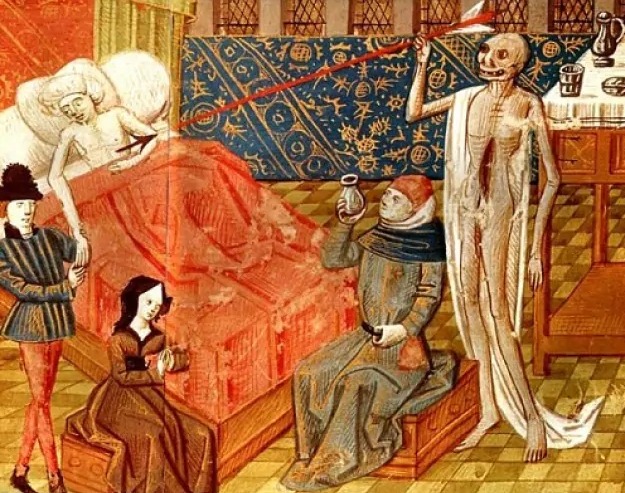Listen to Brenda tell the story
Now that China has ended its zero covid policy, the virus is exploding, prompting the EU to require Chinese passengers to test before boarding a plane to Europe. In other words, it’s back to the good old days. Not the early days of the pandemic, but rather the late 19th century. People have traveled since the dawn of time, often unwittingly packing a most unwelcome hostess gift: disease.
The coronavirus is thought to have originated in a Chinese wildlife market in Wuhan. This is hardly new. While it’s gratifying to get angry and even more so to pin the blame on someone or something – even if it’s just a bat – this is pretty much standard operating procedure for diseases. It was likely rats on trade ships from Asia that brought the plague to Europe, which proceeded to plague the continent in several waves over centuries. In the worst outbreak in the 14th century, it is estimated that a third of Europe’s population was wiped out. It also inspired various statues, plays, and all manner of promises to God – if only the city would be spared from the plague.
In Oberammergau, a small Alpine town of just over 5,000 inhabitants, they vowed to perform a passion play once every 10 years, if only God would in turn promise to spare them from the plague. It worked – or at least they thought it did. But plague deaths aside, a long-lasting side effect is that Oberammergau now has a wonderful tourist magnet, the Passionspiele, on par with Neuschwanstein castle, even if it is only every 10 years. Tickets are pricey and only townspeople can be in the play. If you visit during a performance year, as 2022 was, you’ll notice a lot of people running around with long hair and beards – a requirement for all participants.


The idyllic Croatian port city of Hvar had a straightforward way of keeping diseases out. They simply fired cannons at any ships that tried to anchor there without adhering to the mandatory 40-day quarantine on the island in the harbor. That’s certainly an effective way to keep out any disease-carrying riffraff.
This doesn’t work, though, when you are the one in a walled city. In that case, it’s the ones laying siege who have the advantage. There is at least one documented case of disease being weaponized, in the Genoese city of Caffa (now Feodosija, Ukraine), the western terminus of the Silk Road and thus a major trading port. Mongol attackers catapulted corpses of people who had died from the plague over the city walls to infect its inhabitants. Biological cannonballs, so to speak. Some argue that this is how the plague was introduced to Europe, as infected people fled the city, spreading the disease into the Mediterranean Basin.

Amitchell125, Wikimedia Commons
Passenger ships also carried disease. In the late 19th century, increasing industrialization in the U.S. attracted large numbers of immigrants from Europe and the advent of the railroad made it easier for would-be emigrants to reach ports. Shipping lines required passengers to submit to a medical examination to check for contagious diseases. If they were found to be carriers of typhus, smallpox, cholera, dysentery, or other common diseases, they were rejected.
This may sound harsh, but at the other end, U.S. immigration authorities examined passengers for precisely these diseases. The shipping company was obligated to repatriate any arriving passengers found to be ill – at their own expense. Around 10-20% died during the strenuous voyage anyway, due to crowded conditions and poor hygiene.

U.S. Library of Congress, Public domain, via Wikimedia Commons
The first humans in the Americas arrived on foot from Asia some 20,000 to 30,000 years earlier, depending on who you believe. By doing so, they escaped all of those horrible Old World diseases. It’s a long trek, all the way across Asia, the Bering Strait, then down Alaska and into the rest of the Americas, but by making this journey, these pioneer immigrants escaped the pestilence that haunted Europe.
But why was Europe so prone to pestilence? Domesticated animals, trade, and travel.
Some ingenious people in the Fertile Crescent about 10,000 years ago figured out how to coax sheep, cows, goats, and pigs into a pen to use them as a living grocery store. The close proximity of the animals facilitated the breeding of diseases. Humans living close to these animals – or in the same building, as often happened in Europe – in turn caught these diseases, too.
Over the centuries, Europeans developed some resistance to some of these ailments. Native Americans, thanks to their timely departure from the Asian continent several millennia earlier, had no such luck. Because of their complete lack of immunity to the communicable diseases that had ravaged Europe for centuries, Native Americans were uniquely vulnerable to them.
There is a myth in the U.S. that colonists purposely infected Native Americans with smallpox by gifting them contaminated blankets. While the colonists did many horrible things to the Native Americans, especially to get their land, there is only evidence that they attempted this abominable act, but none that it worked.
Nature did the job for them: within the first 100 years of the European colonization of North America, 90% of the native population had perished.
People are moving around now more than ever before and will surely keep taking their diseases wherever they go. But scientists developed a vaccine against the coronavirus in record time, so there is good reason to hope that whatever disease appears next on the scene, they will find a way to combat that, too.
But we should probably stop stuffing animals into tiny cages with unhygienic conditions and pumping them full of medicine. That might help, too.
Brenda Arnold
Title photo – Black death, artist unknown, public domain, via Wikimedia Commons
